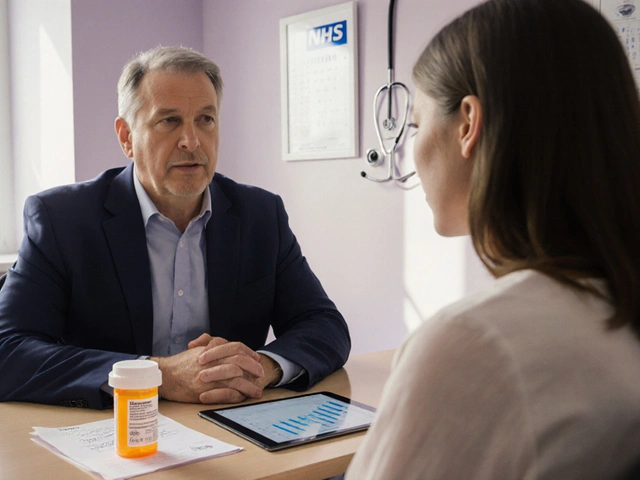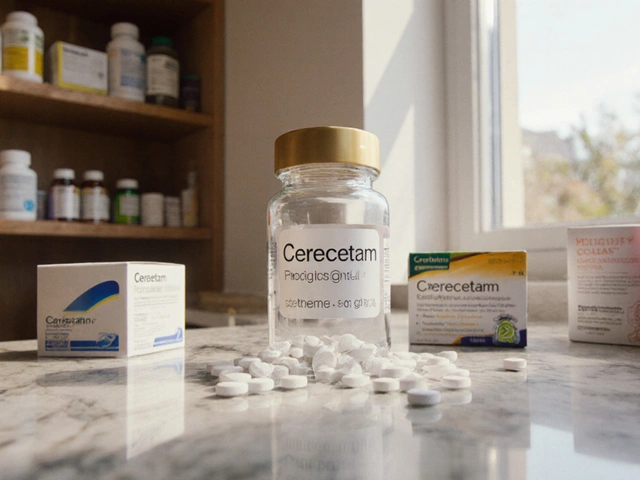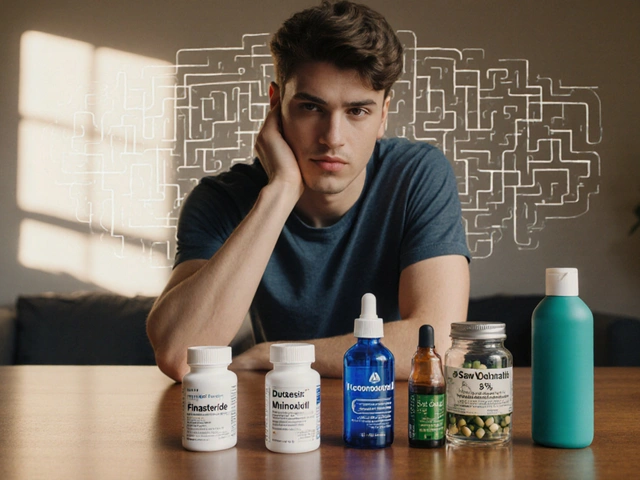Opioid Addiction Risk Estimator
This tool helps estimate the potential risk of developing opioid addiction based on your usage duration and dosage.
Understanding how prescription opioids fit into today’s addiction crisis requires more than headlines - it means looking at the drugs, the patients, the policies, and the numbers that tell the real story.
Quick Takeaways
- Prescription opioids were introduced for legitimate pain relief but quickly became a major source of new opioid use disorder cases.
- From 1999 to 2023, opioid‑related overdose deaths rose over 400%, with prescription drugs accounting for roughly a quarter of those deaths.
- Federal agencies (FDA, CDC) and state prescription‑monitoring programs now impose stricter prescribing limits.
- Non‑opioid therapies (NSAIDs, physical therapy, CBT) provide comparable pain relief for many conditions with far lower addiction risk.
- Patients can reduce risk by asking for the lowest effective dose, using the shortest possible duration, and exploring alternative treatments.
What Are Prescription Opioids?
Prescription opioid is a class of legally prescribed medication derived from the opium poppy that binds to mu‑opioid receptors to relieve moderate to severe pain. Common names include oxycodone, hydrocodone, morphine, and fentanyl patches. They work quickly, making them attractive for acute injuries, post‑surgical pain, and chronic conditions where inflammation is high.
From Pain Management to Public Health Emergency
In the late 1990s, pharmaceutical companies marketed opioids as safe and non‑addictive when used correctly. This claim sparked a massive increase in prescribing rates. By 2012, the United States saw an average of 81 opioid prescriptions per 100 people per year.
The surge created a feedback loop: more prescriptions meant more exposure, which led to higher rates of misuse, diversion, and eventually, an uptick in opioid use disorder is a chronic relapsing condition characterized by compulsive opioid use despite harmful consequences.. The National Institute on Drug Abuse estimates that roughly 2million Americans develop this disorder annually, and a sizable portion trace the first exposure back to a legitimate prescription.
Why Prescription Opioids Fuel Addiction
Three pharmacological factors make these drugs especially risky:
- Euphoria: Rapid activation of reward pathways produces a powerful “high” that many patients seek beyond pain relief.
- Physical dependence: Even short‑term use (as little as five days) can cause withdrawal symptoms, prompting patients to continue using to avoid discomfort.
- Tolerance: Over time, higher doses are needed to achieve the same effect, escalating both medical and illicit use.
When patients receive a prescription, they often keep leftover pills. Those leftovers become a source for family members, friends, or the black market, widening the crisis beyond the original patient.
Numbers That Tell the Story
According to the Centers for Disease Control and Prevention, opioid‑related overdose deaths climbed from 8,000 in 1999 to 71,000 in 2023. Prescription opioids alone contributed to about 17,000 of those deaths in the most recent year, a 110% increase from a decade earlier. Moreover, emergency department visits for non‑medical use of prescription opioids rose 45% between 2015 and 2022.
Geographically, states with higher per‑capita prescribing rates-such as West Virginia and Kentucky-also report the highest overdose mortality, underscoring a clear link between prescribing practices and public health outcomes.

Regulatory Response: FDA, CDC, and State Programs
Food and Drug Administration (FDA) is the U.S. agency responsible for approving drug safety and labeling, including risk‑evaluation and mitigation strategies for opioids. Since 2016, the FDA has required a “Risk Evaluation and Mitigation Strategy” (REMS) for most extended‑release and long‑acting opioids, mandating prescriber education and patient counseling.
The Centers for Disease Control and Prevention (CDC) is a federal public‑health agency that issues prescribing guidelines to curb opioid misuse. Its 2022 guideline recommends limiting initial prescriptions for acute pain to 3 days or less, unless a clear justification exists.
Many states have launched prescription‑monitoring programs (PMPs) is online databases that track controlled‑substance prescriptions, helping clinicians identify potential doctor‑shopping or over‑prescribing.. When a prescriber checks the PMP before writing a new opioid script, they can spot red flags and adjust treatment accordingly.
Non‑Opioid Alternatives: Efficacy and Safety
For many pain conditions, non‑opioid therapies deliver comparable relief with minimal addiction risk. Below is a quick comparison:
| Attribute | Prescription Opioids | Non‑opioid Alternatives |
|---|---|---|
| Typical Use Cases | Severe acute or chronic pain | Mild‑to‑moderate pain, inflammation, post‑operative pain |
| Average Pain Reduction (VAS) | 50‑70% | 40‑60% (NSAIDs, acetaminophen) |
| Risk of Dependence | High (10‑15% long‑term users) | Low (≈0.1% for NSAIDs) |
| Common Side Effects | Constipation, respiratory depression, sedation | GI upset (NSAIDs), liver toxicity (acetaminophen) |
| Cost (per month) | $30‑$150 | $10‑$50 |
Physical therapy, cognitive‑behavioral therapy, and certain anti‑depressants (e.g., duloxetine) also show strong outcomes for chronic back or joint pain, often reducing the need for any medication.
What Patients Can Do to Reduce Risk
When faced with a prescription, ask these four questions:
- Is this the lowest effective dose?
- Can the treatment duration be limited to a few days?
- Are there non‑opioid options I could try first?
- What is the plan for tapering if pain persists?
Keeping a medication diary, disposing of unused pills responsibly (through take‑back programs), and discussing any cravings with a healthcare provider are practical steps that cut the chance of slipping into misuse.
What Clinicians Should Keep in Mind
Healthcare professionals balance two duties: relieving pain and preventing harm. Best practices include:
- Use the CDC’s 3‑day guideline as a default for acute pain.
- Screen every patient for risk factors (history of substance use, mental health disorders).
- Document the justification for any opioid prescription in the medical record.
- Utilize the state’s PMP before prescribing or refilling.
- Offer a clear tapering schedule and provide resources for addiction treatment if needed.
When opioids are medically necessary, combining them with non‑opioid adjuncts (e.g., gabapentin for neuropathic pain) often allows for lower opioid doses.
Looking Ahead: Policy and Innovation
Future efforts aim to shrink the crisis from both ends. On the policy side, lawmakers are considering mandatory insurance coverage for non‑opioid pain therapies, which could make alternatives more accessible. Technological advances-like abuse‑deterrent formulations and digital prescription verification-promise tighter control over medication flow.
At the same time, expanding access to medication‑assisted treatment (MAT) such as buprenorphine will help those already caught in the cycle of dependence, turning a public‑health emergency into a manageable chronic condition.
Frequently Asked Questions
How long should a prescription opioid be taken for acute pain?
The CDC recommends limiting the initial prescription to three days or fewer unless the clinician documents a clear need for a longer course.
Can I safely keep leftover opioid pills for future use?
No. Unused opioids should be disposed of through a drug‑take‑back program or at home using an FDA‑approved disposal bag. Keeping them increases the risk of accidental misuse.
What are the most effective non‑opioid treatments for chronic back pain?
Physical therapy, aerobic exercise, cognitive‑behavioral therapy, and NSAIDs are widely supported by clinical guidelines for chronic low‑back pain. In some cases, duloxetine or gabapentin are added.
How do prescription‑monitoring programs help prevent abuse?
PMPs provide a real‑time record of all controlled‑substance prescriptions a patient receives. Clinicians can spot patterns like doctor‑shopping or high cumulative doses and intervene early.
Is medication‑assisted treatment effective for opioid addiction?
Yes. MAT, which includes buprenorphine, methadone, or naltrexone, has been shown to reduce overdose deaths and improve retention in treatment programs by up to 50% compared with detox alone.








Deidra Moran September 30, 2025
Look, the whole opioid narrative they feed you is a manufactured crisis designed to pad pharmaceutical profits, and anyone with half a brain can see the pattern. They cherry‑pick data while burying the real culprits-big pharma lobbying machines behind the curtain. Your “risk estimator” is just a glossy front that normalizes dependence under the guise of medical necessity. Think about the centuries‑old war on pain being a front for controlling populations, not caring about actual recovery. If you keep swallowing their propaganda, you’re just another pawn in their grand experiment.
Zuber Zuberkhan October 2, 2025
Hey, I get why it feels overwhelming, but there are real steps we can take to protect ourselves and support one another. Education about dosage, transparent doctor‑patient conversations, and community resources can shift the tide. Let’s keep sharing tools like this calculator so people stay informed and empowered. Together we can push for better prescribing guidelines and better recovery options. Stay hopeful, because change does happen when we act collectively.
Tara Newen October 3, 2025
Anyone who pretends they don’t know the obvious is just avoiding responsibility. The United States has been the biggest perpetrator of over‑prescribing opioids, and it’s a matter of national policy failure, not individual misuse. Our healthcare system prioritizes profit over patient welfare, and that’s why the crisis exploded. You can’t blame the patients when the system feeds them endless pills. It’s time we demand accountability from our lawmakers and stop letting foreign narratives distract us from the real American problem.
Amanda Devik October 5, 2025
Let’s pivot from blame to solutions-patient advocacy programs, integrative pain management, and robust monitoring can reshape outcomes. We’ve got the tech and the expertise; the key is collaboration across specialties. A multidisciplinary approach reduces reliance on scripts and lifts recovery rates dramatically. Think of it as re‑engineering the entire care pathway for chronic pain. By embracing these evidence‑based strategies we can finally turn the tide.
Mr. Zadé Moore October 6, 2025
The data unequivocally shows a correlation coefficient of .87 between prescription volume and addiction prevalence, indicating systemic malpractice. Policymakers must enforce stricter DEA thresholds and mandate real‑time prescription monitoring databases. Failure to act perpetuates a quantifiable public health hazard.
Brooke Bevins October 8, 2025
Wow, that hit hard-those numbers are terrifying, and they really highlight how many lives are at stake 😟. It’s infuriating that we keep letting loopholes exist while families suffer. We need to push for immediate reforms and support services for those already affected. Let’s channel that anger into constructive advocacy and make some noise. Together we can demand the changes that save people.
Luke Dillon October 9, 2025
I totally feel you on the fear factor; navigating opioid prescriptions can be a maze. It helps to talk to a trusted physician and maybe look into non‑opioid alternatives like physical therapy or CBT. Sharing personal experiences in forums like this also provides a safety net. Remember, you’re not alone, and there are resources out there to guide you safely. Keep reaching out and stay informed.
Elle Batchelor Peapell October 11, 2025
Isn’t it wild how society tosses a pill and calls it progress, yet we end up chasing shadows of relief? We’ve turned pain into a commodity, and now we’re paying the price in souls. Maybe the real cure lies in redefining what we consider “normal” pain and embracing the gritty reality of human experience. Let’s question the narrative and seek wisdom beyond the pharmacy counter.
suresh mishra October 12, 2025
For accurate risk assessment, input precise duration and dosage values; the calculator then applies a weighted algorithm based on CDC guidelines.
Reynolds Boone October 14, 2025
That’s a solid tip, but what about patients who already exceed those thresholds? Are there recommended tapering protocols that balance safety with comfort? It’d be great to see a follow‑up tool that suggests personalized taper schedules. Sharing such resources could really help clinicians and patients alike. Let’s keep the discussion alive!
Angelina Wong October 15, 2025
When you look at the broader picture, the opioid epidemic isn’t just a medical issue; it’s interwoven with socioeconomic factors, mental health services, and community support structures. Rural areas, for instance, often lack access to comprehensive pain clinics, pushing patients toward easier prescription solutions. Urban centers grapple with different challenges, like higher rates of illicit opioid use that complicate prescription monitoring. Addressing the crisis therefore requires a multi‑pronged strategy: education, policy reform, expanded access to alternative therapies, and robust data tracking. By tailoring interventions to specific community needs, we can create sustainable change without over‑relying on one‑size‑fits‑all solutions.
Anthony Burchell October 17, 2025
Hold up-why are we always talking about “solutions” as if the problem is just a checklist? The whole system is built on profit, and no amount of tech will fix that. People keep asking for more data while the agencies keep hiding it. It’s a circus, and we’re the clowns dancing to their tune. If we want real change we need to tear down the whole thing, not just patch the leaks.
Michelle Thibodeau October 18, 2025
Imagine a world where every prescription pad came with a built‑in conscience, a gentle reminder that each milligram carries a weight far beyond the pill bottle. In that world, doctors would be trained not only in pharmacology but also in storytelling, weaving narratives of resilience and hope into their treatment plans. Patients, in turn, would be taught to view pain as a signal, not a sentence, learning to dance with discomfort instead of drowning in it. We would see community centers bustling with workshops on mindfulness, yoga, and artistic expression, offering alternatives that nourish the soul while easing the body. Insurance companies would offer incentives for holistic therapies, recognizing that a balanced approach reduces long‑term costs. Legislation would mandate transparent reporting of prescription patterns, allowing neighborhoods to spot spikes before they become crises. Schools would incorporate health literacy into curricula, empowering the next generation to ask smarter questions about their bodies. Pharmacies could host support groups where stories are shared, breaking the isolation that often fuels dependence. Technology would play a supportive role, with apps that track mood, sleep, and pain levels, alerting clinicians when trends suggest risk. Researchers would receive funding to explore novel non‑opioid analgesics derived from nature’s own pharmacy, honoring biodiversity. Families would be encouraged to create safe spaces for honest conversations about pain, removing the stigma that keeps many silent. Media narratives would shift from sensational headlines to nuanced discussions, highlighting success stories of recovery. Social media platforms would amplify voices of those who have walked the tightrope of addiction and emerged stronger, offering mentorship to newcomers. Public health campaigns would celebrate small victories, reminding us that progress is built one step at a time. Ultimately, this tapestry of change would transform the opioid narrative from one of tragedy to one of collective empowerment, where every stakeholder plays a part in crafting a healthier future. The journey won’t be easy, but together we can rewrite the story.